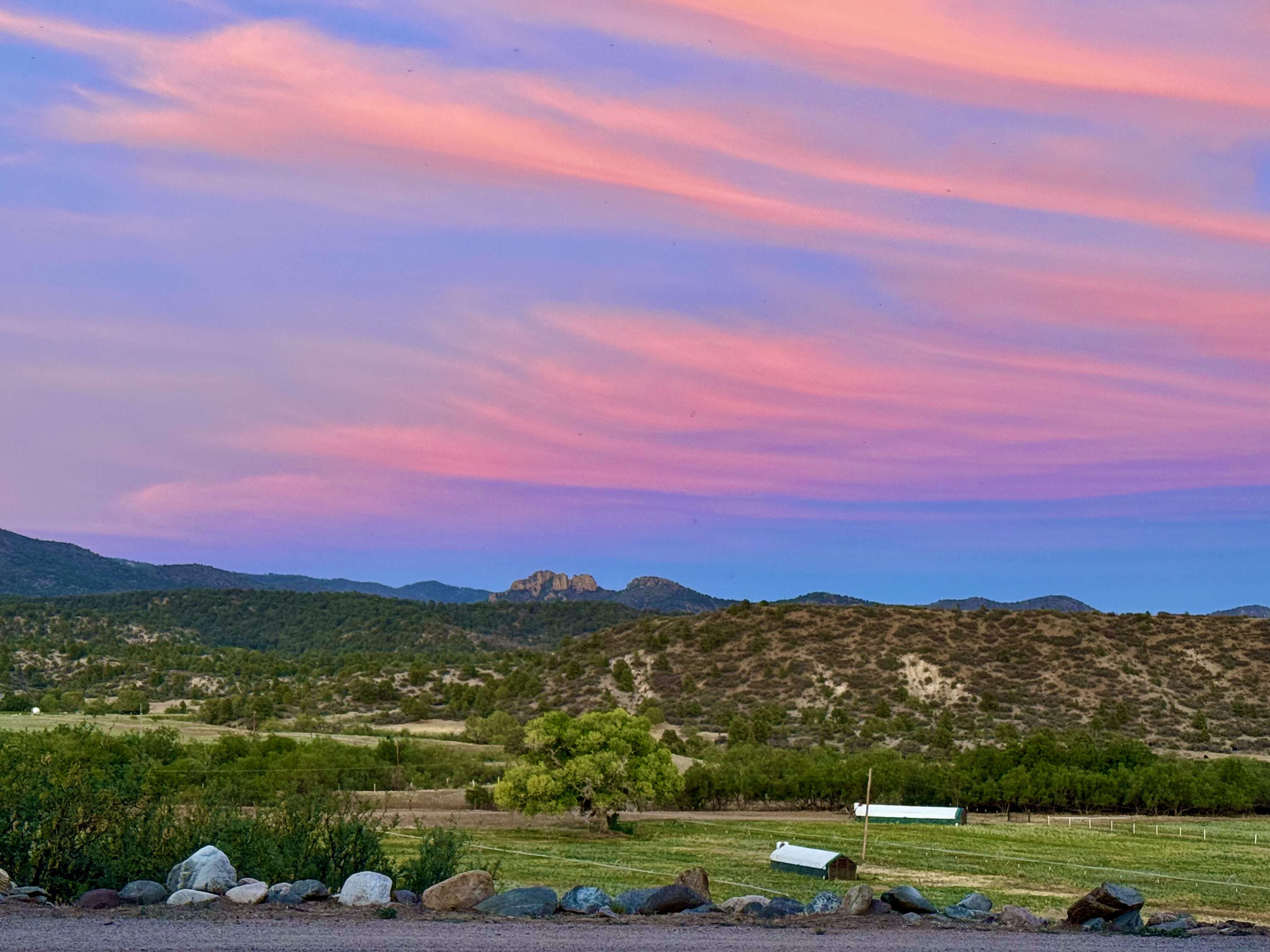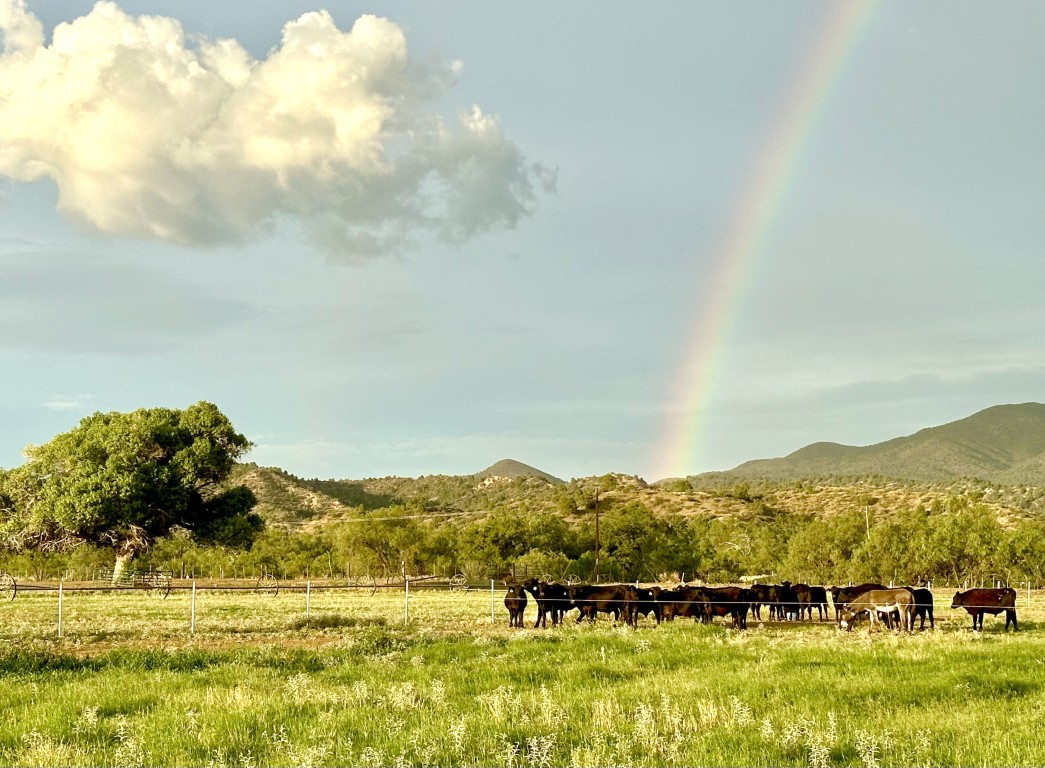
I started my research for this story at the only business in Skull Valley, The Forge Cafe, which is a restaurant, coffee bar and small store serving all natural beef, poultry and sausage from Iron Springs Ranch. The Forge was originally a blacksmith shop, then a gas station, then a coffee stop, and now a charming meeting site for Skull Valley folk and passersby. I am welcomed by a sturdy blonde, warmly smiling, Katie Ross. We sit down together over a delicious lunch. (I had the Outlaw Wrap: chicken, sweet chili bacon, avocado, red onion, red cabbage and secret sauce.) Katie is the Iron Springs Ranch manager. With a BS in animal science and years of experience, she and her firefighter husband John have managed this historic ranch (formerly part of the A Bar V) for two years.
Iron Springs Ranch is owned by Troy and Claire Eckhard, who are dedicated to turning this historic ranch into a property that focuses on restoring and building the health of the natural ecosystem. Troy and Claire also own The Forge, and today Claire is hands-on in The Forge kitchen.
Bringing the ranch health into ecological balance starts with building the soil by maintaining the plant cover and minimizing soil disturbance. We jump in the ranch ATV and Katie takes me to see how this works. We pass through a pasture, one side grazed by conventional methods, looking damaged, with dust and scraggly weed patches, and the other side grazed with a regenerative system, where the herd is moved frequently. That side is nicely grassed over. With regenerative grazing animals are restricted to designated plots and moved frequently to mirror wild-herd grazing. This rotation-grazing allows fields time to recover and restore.
Restoration time is dependent on the land, the weather and the climate. Today we’re in the middle of a drought, but I was thrilled to be exploring following a rare heavy rain. Katie says “We’re in the business of growing grass and healthy soil. The animals are secondary.” She’s not sure when the cattle will return to this plot. “When Mother Nature is your business partner, you have a lot of unknowns.”
Iron Springs Ranch cattle are handled with a minimum of stress, nice and easy. Katie knows them all. They come to her when called. They are born on the ranch and spend their entire lives there, all on natural bottom land and ranch hillsides. No cattle are shipped to CAFOs — feedlots where thousands are held in crowded pens, fed unnatural feeds and antibiotics that cause them to gain weight fast, so they can be processed after six months.

John manages the poultry operation, producing chickens and turkeys for Thanksgiving. He is also in charge of spicing the incredible chicken and beef sausage. This is pasture-raised poultry, raised outside with sunlight, grass and insects to eat and dirt to scratch around in. Poultry are housed in portable pens, called chicken tractors, that are moved daily. The chickens and turkeys can stretch and run and express their natural characteristics. The chickens are a heritage breed (Freedom Rangers) instead of the commercial types that are genetically selected to develop extra big breasts. They are grown for 12-18 weeks instead of the conventional six to eight weeks. Turkeys are produced for Thanksgiving only, so get your order in soon. (For ordering information see the Resources section online with this column at 5ensesmag.com.)
The ranch contains both bottom land and hillsides. Cattle are moved with a geofencing system. Each cow is fitted with a tracking collar. Kate shows me her phone. “All these dots are cows. The blue are steers. Red are heifers. I can click on each one to see who it is. The collars talk to our GPS signal towers.” Eight towers are installed around the 5,500 acre ranch to signal the collars to vibrate, keeping cattle from crossing grazing borders. Cattle can be herded this way to keep them rotating between plots (though they are still sometimes herded the conventional way, with horses). As we drive the ranch Katie explains that regenerative practices don’t take long to make a difference. This 100-year-old ranch shows a lot of improvement with just a few years of rotational grazing.
We end our tour at The Lookout, the site of one of the new GPS towers, with the beautiful ranch spread out below us. Katie again emphasizes that by working with natural systems instead of against them we can produce healthy soil, a healthy planet, healthy animals and healthy humans. Regenerative ranching protects soil and water quality, sequesters carbon and supports wildlife. Regenerative practices yield leaner, nutrient-dense meat with a healthier nutritional profile, increased vitamins and minerals, and lower antibiotic and chemical residues, and it tastes dang great! I brought some home. Delicious. It’s meat truly worth eating.
Chef Molly Beverly is Prescott's leading creative food activist and teacher. Photos by Gary Beverly.